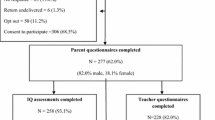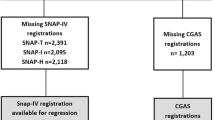Abstract
We compared symptoms of generalized anxiety disorder (GAD) and separation anxiety disorder (SAD) in 5 groups of boys with neurobehavioral syndromes: attention-deficit/hyperactivity disorder (ADHD) plus autism spectrum disorder (ASD), ADHD plus chronic multiple tic disorder (CMTD), ASD only, ADHD only, and community Controls. Anxiety symptoms were assessed using parent and teacher versions of a DSM-IV-referenced rating scale. All three groups of boys with co-morbid ADHD evidenced more severe anxiety than Controls. Group differences in anxiety varied as a function of symptom, disorder, informant, and co-morbidity supporting the notion that co-morbid neurobehavioral syndromes differentially impact clinical features of co-occurring anxiety symptoms. Findings also suggest that GAD and SAD are phenomenologically unique, even in children with ASD. Implications for nosology are discussed.
Similar content being viewed by others
References
American Psychiatric Association. (1987). Diagnostic and statistical manual of mental disorders, 3rd edition, revised (DSM-III-R). Washington, DC: American Psychiatric Association.
American Psychiatric Association. (1994). Diagnostic and statistical manual of mental disorders, 4th ed. (DSM-IV). Washington, DC: American Psychiatric Association.
Belzung, C., & Philippot, P. (2007). Anxiety from a phylogenetic perspective: Is there a qualitative difference between human and animal anxiety? Neural Plasticity, 59676.
Bracha, H. S. (2006). Human brain evolution and the ‘neuroevolutionary time-depth principle’. Progress in Neuro-Psychopharmacology & Behavioral Psychiatry, 30, 827–853.
Cohen, I. L., Liu, X., Schultz, C., White, B. N., Jenkins, E. C., Brown, W. T., et al. (2003). Association of autism severity with a monoamine oxidase A functional polymorphism. Clinical Genetics, 64, 190–197.
Comings, D. E. (1990). Tourette syndrome and human behavior. Duarte, CA: Hope Press.
Comings, D. E., Wu, S., Chiu, C., Ring, R. H., Gade, R., Ahn, C., et al. (1996). Polygenetic inheritance of Tourette syndrome, stuttering, attention deficit hyperactivity, conduct, and oppositional defiant disorder. American Journal of Medical Genetics. Part B, Neuropsychiatric Genetics, 67B, 264–288.
Darwin, C. (1872). The expression of emotions in man and animals. London: John Murray.
de Bruin, E. I., Ferdinand, R. F., Meester, S., de Nijs, P. F., & Verheij, F. (2007). High rates of psychiatric co-morbidity in PDD-NOS. Journal of Autism and Developmental Disorders, 37, 877–886.
DeVincent, C. J., & Gadow, K. D. (2009). Relative clinical utility of three Child Symptom Inventory-4 scoring algorithms for differentiating children with autism spectrum disorder versus attention-deficit hyperactivity disorder. Autism Research, 2, 312–321.
Feise, R. J. (2002). Do multiple outcome measures require p-value adjustment? BMC Medical Research Methodology, 2, 8–11.
Gadow, K. D., & DeVincent, C. J. (2005). Clinical significance of tics and attention-deficit hyperactivity disorder (ADHD) in children with pervasive developmental disorder. Journal of Child Neurology, 20, 481–488.
Gadow, K. D., DeVincent, C. J., Olvet, D. M., & Hatchwell, E. (2009a). Association of DRD4 polymorphism with severity oppositional defiant, separation anxiety, and repetitive behaviors in children with autism spectrum disorder. Manuscript submitted for publication.
Gadow, K. D., DeVincent, C. J., & Pomeroy, J. (2006). ADHD symptom subtypes in children with pervasive developmental disorder. Journal of Autism and Developmental Disorders, 36, 271–283.
Gadow, K. D., DeVincent, C. J., Pomeroy, J., & Azizian, A. (2005). Comparison of DSM-IV symptoms in elementary school-aged children with ASD versus clinic and community samples. Autism, 9, 392–415.
Gadow, K. D., DeVincent, C. J., & Schneider, J. (2008a). Predictors of psychiatric symptoms in children with an autism spectrum disorder. Journal of Autism and Developmental Disorders, 38, 1710–1720.
Gadow, K. D., DeVincent, C. J., & Schneider, J. (2009b). Comparative study of children with ADHD only, autism spectrum disorder + ADHD, and chronic multiple tic disorder + ADHD. Journal of Attention Disorders, 12, 474–485.
Gadow, K. D., Drabick, D. A. G., Loney, J., Sprafkin, J., Salisbury, H., Azizian, A., et al. (2004). Comparison of ADHD symptom subtypes as source-specific syndromes. Journal of Child Psychology and Psychiatry, 45, 1135–1149.
Gadow, K. D., Nolan, E. E., Sprafkin, J., & Schwartz, J. (2002). Tics and psychiatric comorbidity in children and adolescents. Developmental Medicine and Child Neurology, 44, 330–338.
Gadow, K. D., Roohi, J., DeVincent, C. J., & Hatchwell, E. (2008b). Association of ADHD, tics, and anxiety with dopamine transporter (DAT1) genotype in autism spectrum disorder. Journal of Child Psychology and Psychiatry, 49, 1331–1338.
Gadow, K. D., Roohi, J., DeVincent, C. J., Kirsch, S., & Hatchwell, E. (2009c). Association of COMT (Val158Met) and BDNF (Val66Met) gene polymorphisms with anxiety, ADHD and tics in children with autism spectrum disorder. Journal of Autism and Developmental Disorders, 39, 1542–1551. doi:10.1007/s10803-009-0794-4.
Gadow, K. D., Schwartz, J., DeVincent, C., Strong, G., & Cuva, S. (2008c). Clinical utility of autism spectrum disorder scoring algorithms for the Child Symptom Inventory. Journal of Autism and Developmental Disorders, 38, 419–427.
Gadow, K. D., & Sprafkin, J. (1986). Stony Brook child psychiatric checklist-3. Stony Brook: Department of Psychiatry, State University of New York.
Gadow, K. D., & Sprafkin, J. (1994). Child symptom inventories manual. Stony Brook, NY: Checkmate Plus.
Gadow, K. D., & Sprafkin, J. (2002). Child Symptom Inventory-4 screening and norms manual. Stony Brook, NY: Checkmate Plus.
Gadow, K. D., & Sprafkin, J. (2008). The symptom inventories: An annotated bibliography [on-line]. Available: www.checkmateplus.com.
Gadow, K. D., Sverd, J., Nolan, E. E., Sprafkin, J., & Schneider, J. (2007). Immediate-release methylphenidate for ADHD in children with comorbid chronic multiple tic disorder. Journal of the American Academy of Child and Adolescent Psychiatry, 46, 840–848.
Happé, F., & Ronald, A. (2008). The ‘fractionable autism triad’: A review of evidence from behavioral, genetic, cognitive and neural research. Neuropsychology Review, 18, 287–304.
Lecavalier, L., Gadow, K. D., DeVincent, C. J., & Edwards, M. C. (2009). Validation of DSM-IV model of psychiatric syndromes in children with autism spectrum disorder. Journal of Autism and Developmental Disorders, 39, 278–289.
Leckman, J. F., Riddle, M. A., Hardin, M. T., Ort, S. I., Swartz, K. L., Stevenson, J., et al. (1989). The Yale global tic severity scale: Initial testing of a clinic-rated scale of tic severity. Journal of the American Academy of Child and Adolescent Psychiatry, 28, 566–573.
Lord, C., Risi, S., Lambrecht, L., Cook, E. H., Jr, Leventhal, B. L., DiLavore, P. C., et al. (2000). The autism diagnostic observation schedule-generic: A standard measure of social and communication deficits associated with the spectrum of autism. Journal of Autism and Developmental Disorders, 30, 205–223.
Myles, B., Barnhill, G., Hagiwara, T., Griswold, D., & Simpson, R. (2001). A synthesis of studies on the intellectual, academic, social/emotional and sensory characteristics of children with asperger syndrome. Education and Training in Mental Retardation and Developmental Disabilities, 36, 304–311.
Nesse, R. M. (1999). Proximate and evolutionary studies of anxiety, stress and depression: Synergy at the interface. Neuroscience and Behavioral Reviews, 23, 895–903.
Nolan, E. E., Gadow, K. D., & Sverd, J. (1994). Observations and ratings of tics in school settings. Journal of Abnormal Child Psychology, 22, 579–593.
Olatunji, B. O., & Cole, D. A. (2009). The longitudinal structure of general and specific anxiety dimensions in children: Testing a latent trait-state-occasion model. Psychological Assessment, 21, 412–424.
Perneger, T. V. (1998). What’s wrong with Bonferroni adjustments. BMJ, 316, 1236–1238.
Pierre, C. B., Nolan, E. E., Gadow, K. D., Sverd, J., & Sprafkin, J. (1999). Comparison of internalizing and externalizing symptoms in children with attention-deficit hyperactivity disorder with and without comorbid tic disorder. Journal of Developmental and Behavioral Pediatrics, 20, 170–176.
Reich, W. (2000). Diagnostic interview for children and adolescents (DICA). Journal of the American Academy of Child and Adolescent Psychiatry, 39, 59–66.
Roessner, V., Becker, A., Banaschewski, T., & Rothenberger, A. (2007). Psychological profile in children with chronic tic disorder and co-existing ADHD: Additive effects. Journal of Abnormal Child Psychology, 35, 79–85.
Rothman, K. (1990). No adjustments are needed for multiple comparisons. Epidemiology, 1, 43–46.
Rowe, D. C., Stever, C., Gard, J. M. C., Cleveland, H. H., Sanders, M. L., Abramowitz, A., et al. (1998). The relation of the dopamine transporter gene (DAT1) to symptoms of internalizing disorders in children. Behavior Genetics, 28, 215–225.
Schneider, J., Gadow, K. D., Crowell, J. A., & Sprafkin, J. (2009). Anxiety in boys with ADHD with and without chronic multiple tic disorder. Journal of Child and Adolescent Psychopharmacology, 19, 1–12. doi:10.1089/cap.2009.0013.
Sherrington, C. S. (1900). Experimentation in emotion. Nature, 62(1065), 328–331.
Simonoff, E., Pickles, A., Charman, T., Chandler, S., Loucas, T., & Baird, G. (2008). Psychiatric disorders in children with autism spectrum disorders: Prevalence, comorbidity, and associated factors in a population-derived sample. Journal of the American Academy of Child and Adolescent Psychiatry, 47, 921–929.
Sprafkin, J., Volpe, R. J., Gadow, K. D., Nolan, E. E., & Kelly, K. (2002). A DSM-IV-referenced screening instrument for preschool children: The Early Childhood Inventory-4. Journal of the American Academy of Child and Adolescent Psychiatry, 41, 604–612.
Sukhodolsky, D. G., Scahill, L., Zhang, H., Peterson, B. S., King, R. A., Lombroso, P. J., et al. (2003). Disruptive behavior in children with Tourette’s syndrome: Association with ADHD co-morbidity, tic severity, and functional impairment. Journal of the American Academy of Child and Adolescent Psychiatry, 42, 98–105.
Weisbrot, D. M., Gadow, K. D., DeVincent, C. J., & Pomeroy, J. (2005). The presentation of anxiety in children with pervasive developmental disorders. Journal of Child and Adolescent Psychopharmacology, 15, 477–496.
White, S. W., Oswald, D., Ollendick, T., & Scahill, L. (2009). Anxiety in children and adolescents with autism spectrum disorders. Clinical Psychology Review, 29, 216–229.
Zhang, J., Quan, H., Ng, J., & Stepanavage, M. E. (1997). Some statistical methods for multiple endpoints in clinical trials. Controlled Clinical Trials, 18, 204–221.
Acknowledgments
This study was supported, in part, by grants awarded to Dr. Gadow from the Tourette Syndrome Association, Inc., National Institute of Mental Health (MH 45358), and the Matt and Debra Cody Center for Autism and Developmental Disorders. The authors wish to thank Dr. John Pomeroy, Dr. Joyce Sprafkin, and Dr. Jeff Sverd for their respective roles in the diagnostic evaluations and anonymous reviewers for their helpful comments.
Author information
Authors and Affiliations
Corresponding author
Rights and permissions
About this article
Cite this article
Guttmann-Steinmetz, S., Gadow, K.D., DeVincent, C.J. et al. Anxiety Symptoms in Boys with Autism Spectrum Disorder, Attention-Deficit Hyperactivity Disorder, or Chronic Multiple Tic Disorder and Community Controls. J Autism Dev Disord 40, 1006–1016 (2010). https://doi.org/10.1007/s10803-010-0950-x
Published:
Issue Date:
DOI: https://doi.org/10.1007/s10803-010-0950-x




